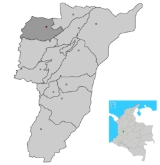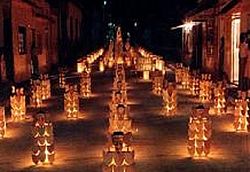
Quimbaya, Quindío
Encyclopedia
Quimbaya is a town and municipality in the western part of the department of Quindío
, Colombia
. It is 20 km northwest of the departmental capital Armenia
. The name of the city derives from the name of the Precolumbian culture that inhabited the area, the Quimbaya civilization
.
Quimbaya is bounded to the north and west by the department of Valle del Cauca, with La Vieja River
forming the western limit. To the south, the Roble River forms the limit with the municipalities of Montenegro
and Circasia. The eastern boundary is with the municipality of Filandia
.
 Quimbaya was founded in 1914 by Juan de J. Buitrago, and became a municipality in 1922. In 2005 it had an estimated population of 43,700, of which 31,300 live in the main urban zone.
Quimbaya was founded in 1914 by Juan de J. Buitrago, and became a municipality in 1922. In 2005 it had an estimated population of 43,700, of which 31,300 live in the main urban zone.
The National Agricultural and livestock Park (Spanish
: El Parque Natural De La Cultura Agropecuaria), PANACA, is located 7 km west of the main township. The 47 hectare park contains a variety of interactive exhibits, including more than 200 species of animals. Along with the National Coffee Park in Montenegro, the theme park is one of major tourist attractions of
the department.
 The most important cultural event is the Candles and Lanterns Festival (full name in Spanish: Fiesta Nacional del Concurso de Alumbrados con Velas y Faroles), which began in 1982 and is held each year on 7 and 8 December (Día de las Velitas
The most important cultural event is the Candles and Lanterns Festival (full name in Spanish: Fiesta Nacional del Concurso de Alumbrados con Velas y Faroles), which began in 1982 and is held each year on 7 and 8 December (Día de las Velitas
). Each of the barrio
s in the township compete to produce the most spectacular lighting arrangements, and many visitors come from throughout Colombia to admire the displays. The festival is held in honor of the Catholic holy day, the Feast of the Immaculate Conception
, on 8 December.
Quindío Department
Quindío is a department of Colombia. It is in the western central region of the country, crossed by the Andes mountains. Its capital is Armenia. It is famous for the quality of the coffee plantations, colorful architecture, benign weather, variety of hotel accommodations and touristic landmarks...
, Colombia
Colombia
Colombia, officially the Republic of Colombia , is a unitary constitutional republic comprising thirty-two departments. The country is located in northwestern South America, bordered to the east by Venezuela and Brazil; to the south by Ecuador and Peru; to the north by the Caribbean Sea; to the...
. It is 20 km northwest of the departmental capital Armenia
Armenia, Colombia
Armenia is the capital of Quindío, a department in Colombia. The city is located at coordinates 4.5170° north, 75.6830° west, 290 kilometers west of Bogotá. Armenia is a mid-size city located between Bogotá, Medellín and Cali, the 3 largest Colombian cities. The city's area code for phone calls is...
. The name of the city derives from the name of the Precolumbian culture that inhabited the area, the Quimbaya civilization
Quimbaya civilization
The Quimbaya civilization is a South American civilization, noted for spectacular gold work characterized by technical accuracy and detailed designs. The majority of the gold work is made in tumbaga alloy, with 30% copper, which imparts beautiful color tonalities to the pieces...
.
Quimbaya is bounded to the north and west by the department of Valle del Cauca, with La Vieja River
La Vieja River
La Vieja River is a river in the Colombiandepartments of Quindío, Valle del Cauca and Risaralda.It is a major tributary of the Cauca River.The river is formed by the joining of the Quindío River and the...
forming the western limit. To the south, the Roble River forms the limit with the municipalities of Montenegro
Montenegro, Quindío
Montenegro is a municipality in the western part of the department of Quindío, Colombia. It is located 10 km west of the departmental capital Armenia....
and Circasia. The eastern boundary is with the municipality of Filandia
Filandia, Quindío
Filandia is a town and municipality in the northern part of the department of Quindío, Colombia. It is located on the west side of Cordillera Central of the Andes mountain range running through central Colombia, 26 km north of the departmental capital Armenia. It is the northernmost of twelve...
.

The National Agricultural and livestock Park (Spanish
Spanish language
Spanish , also known as Castilian , is a Romance language in the Ibero-Romance group that evolved from several languages and dialects in central-northern Iberia around the 9th century and gradually spread with the expansion of the Kingdom of Castile into central and southern Iberia during the...
: El Parque Natural De La Cultura Agropecuaria), PANACA, is located 7 km west of the main township. The 47 hectare park contains a variety of interactive exhibits, including more than 200 species of animals. Along with the National Coffee Park in Montenegro, the theme park is one of major tourist attractions of
the department.

Día de las Velitas
Día de las Velitas is one of the most observed traditional holidays of Colombia. It is celebrated on December 7, on the eve of the Immaculate Conception, which is a public holiday in Colombia...
). Each of the barrio
Barrio
Barrio is a Spanish word meaning district or neighborhood.-Usage:In its formal usage in English, barrios are generally considered cohesive places, sharing, for example, a church and traditions such as feast days...
s in the township compete to produce the most spectacular lighting arrangements, and many visitors come from throughout Colombia to admire the displays. The festival is held in honor of the Catholic holy day, the Feast of the Immaculate Conception
Immaculate Conception
The Immaculate Conception of Mary is a dogma of the Roman Catholic Church, according to which the Virgin Mary was conceived without any stain of original sin. It is one of the four dogmata in Roman Catholic Mariology...
, on 8 December.

